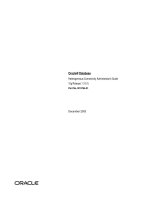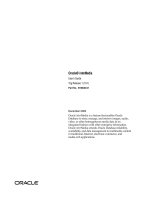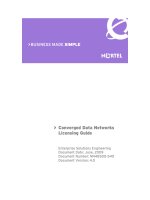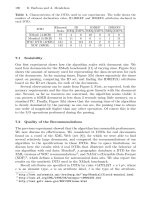Tài liệu Installation and User’s Guide ppt
Bạn đang xem bản rút gọn của tài liệu. Xem và tải ngay bản đầy đủ của tài liệu tại đây (2.94 MB, 254 trang )
Oracle® Transparent Gateway for DRDA
Installation and User’s Guide
10g Release 1 (10.1.0.2.0) for Microsoft Windows
Part Number B12010-01
March 2004
Oracle Transparent Gateway for DRDA Installation and User's Guide, 10g Release 1 (10.1.0.2.0) for Microsoft
Windows
Part Number B12010-01
Copyright © 2001, 2004, Oracle. All rights reserved.
Primary Author: Platform Technologies Division
The Programs (which include both the software and documentation) contain proprietary information; they
are provided under a license agreement containing restrictions on use and disclosure and are also protected
by copyright, patent, and other intellectual and industrial property laws. Reverse engineering, disassembly,
or decompilation of the Programs, except to the extent required to obtain interoperability with other
independently created software or as specified by law, is prohibited.
The information contained in this document is subject to change without notice. If you find any problems in
the documentation, please report them to us in writing. This document is not warranted to be error-free.
Except as may be expressly permitted in your license agreement for these Programs, no part of these
Programs may be reproduced or transmitted in any form or by any means, electronic or mechanical, for any
purpose.
If the Programs are delivered to the United States Government or anyone licensing or using the Programs on
behalf of the United States Government, the following notice is applicable:
U.S. GOVERNMENT RIGHTS Programs, software, databases, and related documentation and technical data
delivered to U.S. Government customers are "commercial computer software" or "commercial technical data"
pursuant to the applicable Federal Acquisition Regulation and agency-specific supplemental regulations. As
such, use, duplication, disclosure, modification, and adaptation of the Programs, including documentation
and technical data, shall be subject to the licensing restrictions set forth in the applicable Oracle license
agreement, and, to the extent applicable, the additional rights set forth in FAR 52.227-19, Commercial
Computer Software Restricted Rights (June 1987). Oracle Corporation, 500 Oracle Parkway, Redwood City,
CA 94065
The Programs are not intended for use in any nuclear, aviation, mass transit, medical, or other inherently
dangerous applications. It shall be the licensee's responsibility to take all appropriate fail-safe, backup,
redundancy and other measures to ensure the safe use of such applications if the Programs are used for such
purposes, and we disclaim liability for any damages caused by such use of the Programs.
Oracle is a registered trademark of Oracle Corporation and/or its affiliates. Other names may be trademarks
of their respective owners.
The Programs may provide links to Web sites and access to content, products, and services from third
parties. Oracle is not responsible for the availability of, or any content provided on, third-party Web sites.
You bear all risks associated with the use of such content. If you choose to purchase any products or services
from a third party, the relationship is directly between you and the third party. Oracle is not responsible for:
(a) the quality of third-party products or services; or (b) fulfilling any of the terms of the agreement with the
third party, including delivery of products or services and warranty obligations related to purchased
products or services. Oracle is not responsible for any loss or damage of any sort that you may incur from
dealing with any third party.
iii
Contents
Send Us Your Comments xv
Preface xvii
Intended Audience xvii
Processors xviii
Documentation Accessibility xviii
Related Documents xviii
Conventions xix
SQL*Plus Prompts xx
DOS Prompts xx
Storage Measurements xx
1 Introduction
1.1 Introduction to the Oracle Transparent Gateway 1-2
1.1.1 Protection of Current Investment 1-2
1.2 Release 10g Gateways 1-2
1.2.1 Advantages of the Gateway 1-3
1.3 Gateway Capabilities 1-3
1.3.1 Transparency at All Levels 1-3
1.3.2 Extended Database Services 1-4
1.3.3 Extended Advanced Networking, Internet and Intranet Support 1-4
1.3.4 Dynamic Dictionary Mapping 1-5
1.3.5 SQL 1-5
1.3.6 Data Definition Language 1-5
1.3.7 Data Control Language 1-5
1.3.8 Passthrough and Native DB2 SQL 1-5
1.3.9 Stored Procedures 1-6
1.3.9.1 Oracle Stored Procedures 1-6
1.3.9.2 Native DB2 Stored Procedures 1-6
1.3.10 Languages 1-6
1.3.11 Oracle Database Server Technology and Tools 1-6
1.3.12 SQL*Plus 1-6
1.3.13 Two-Phase Commit and multi-site Transactions 1-6
1.3.14 Site Autonomy 1-7
1.3.15 Migration and Coexistence 1-7
iv
1.3.16 Security 1-7
1.4 Terms 1-7
1.5 Architecture 1-8
1.6 Implementation 1-9
1.7 How the Gateway Works 1-9
1.7.1 SQL Differences 1-10
1.8 Oracle Tools and the Gateway 1-10
1.8.1 SQL*Plus 1-10
1.9 Features 1-11
1.9.1 Heterogeneous Services Architecture 1-11
1.9.2 Performance Enhancements 1-11
1.9.3 Fetch Reblocking 1-11
1.9.4 Oracle Database 10g Passthrough Supported 1-11
1.9.5 Retrieving Result Sets Through Passthrough 1-11
1.9.6 Support for TCP/IP 1-11
1.9.7 Native Semantics 1-11
1.9.8 Columns Supported in a Result Set 1-12
1.9.9 EXPLAIN_PLAN Improvement 1-12
1.9.10 Heterogeneous Database Integration 1-12
1.9.11 Minimum Impact on Existing Systems 1-12
1.9.12 Large Base of Data Access 1-12
1.9.13 Application Portability 1-12
1.9.14 Remote Data Access 1-12
1.9.15 Support for Distributed Applications 1-13
1.9.16 Application Development and End User Tools 1-13
1.9.17 Password Encryption Utility 1-13
1.9.18 Support for DB2/OS390 V6 and V7 Stored Procedures 1-13
1.9.19 Codepage Map Facility 1-14
1.9.20 IBM DB2 Universal Database Support 1-14
1.9.21 IBM DB2 Version 5.1 ASCII Tables 1-14
1.9.22 Read-Only Support 1-14
2 Release Information
2.1 Product Set 2-2
2.2 Changes and Enhancements 2-2
2.3 Bugs Fixed in Release 10 2-2
2.4 Known Problems 2-3
2.5 Known Restrictions 2-3
2.5.1 DB2 Considerations 2-3
2.5.2 SQL Limitations 2-6
3 System Requirements
3.1 Hardware Requirements 3-2
3.1.1 Processor 3-2
3.1.2 Memory 3-2
3.1.3 Network Attachment 3-2
3.1.4 CD-ROM Drive 3-2
v
3.1.5 Disk Space 3-2
3.2 Software Requirements 3-2
3.2.1 Operating System 3-3
3.2.2 DRDA Databases 3-3
3.2.3 Communications 3-3
3.2.4 Oracle Database server 3-3
3.2.5 Oracle Networking Products 3-4
3.3 Documentation Requirements 3-4
4 Installing the Gateway
4.1 Introduction 4-2
4.2 Before You Begin 4-2
4.3 Checklist for Gateway Installation 4-2
4.4 Installation Overview 4-3
4.5 Preinstallation 4-3
4.6 Installing the Gateway from CD-ROM 4-3
4.6.1 Step 1: Log on to the host 4-3
4.6.2 Step 2: Load the CD-ROM into the CD-ROM Drive 4-3
4.6.3 Step 3: Start the Oracle Universal Installer on Microsoft Windows 4-3
4.6.4 Step 4: Step through the Oracle Universal Installer 4-4
4.6.5 Step 5: Verify Installation Success 4-4
4.7 Installation Complete 4-4
4.7.1 Deinstalling the Gateway 4-4
5 Configuring the DRDA Server
5.1 Checklists for Configuring the DRDA Server 5-2
5.1.1 DB2/OS390 5-2
5.1.2 DB2/400 5-2
5.1.3 DB2/UDB (Universal Database) 5-2
5.1.4 DB2/VM 5-2
5.2 DB2/OS390 5-3
5.2.1 Step 1: Configure the Communications Server 5-3
5.2.2 Step 2: Define the user ID that owns the package 5-3
5.2.3 Step 3: Define the recovery user ID 5-3
5.2.4 Step 4: Determine DRDA location name for DB2 instance 5-4
5.2.5 Step 5: Configure DB2 Distributed Data Facility for gateway 5-4
5.3 DB2/400 5-4
5.3.1 Step 1: Configure the Communications Server 5-4
5.3.2 Step 2: Define the user ID that owns the package 5-4
5.3.3 Step 3: Define the recovery user ID 5-5
5.3.4 Step 4: Determine DRDA location name for DB2/400 instance 5-5
5.4 DB2/UDB (Universal Database) 5-5
5.4.1 Step 1: Configure the SNA Communications Server 5-5
5.4.2 Step 2: Define the user ID that owns the package 5-6
5.4.3 Step 3: Define the recovery user ID 5-6
5.4.4 Step 4: Determine DRDA location name for DB2/UDB instance 5-6
vi
5.5 DB2/VM 5-7
5.5.1 Step 1: Configure the Communications Server 5-7
5.5.2 Step 2: Define the user ID that owns the package 5-7
5.5.3 Step 3: Define the recovery user ID 5-7
5.5.4 Step 4: Determine DRDA location name for DB2/VM instance 5-7
6 Configuring Microsoft SNA Server or Host Integration Server
6.1 Before You Begin 6-2
6.2 Steps for Configuring the Communications Interfaces 6-2
6.3 Creating SNA Server Profiles for the Gateway 6-2
6.3.1 Independent Versus Dependent LUs 6-2
6.4 Creating SNA Definitions for the Gateway 6-3
6.4.1 Sample SNA Server Definitions 6-3
6.4.2 Definition Types 6-3
6.4.3 SNA Server Definitions 6-4
6.4.3.1 Server Selection 6-4
6.4.3.2 Service Properties 6-5
6.4.3.3 Link Service Definition 6-5
6.4.3.4 Connection Definition 6-7
6.4.3.5 Local LU Definition 6-9
6.4.3.6 Mode Definition 6-11
6.4.3.7 Remote LU Definition 6-13
6.4.3.8 CPI-C Symbolic Destination Names 6-14
6.5 Testing the Connection 6-15
6.6 Using SNA Session Security Validation 6-16
6.7 SNA Conversation Security 6-17
6.7.1 SNA Security Option SECURITY=PROGRAM 6-17
6.7.2 SNA Security Option SECURITY=SAME 6-17
7 Configuring IBM Communication Server
7.1 Before You Begin 7-2
7.2 Checklist for Configuring the Communications Interfaces 7-2
7.3 Creating IBM Communication Server Profiles for the Gateway 7-2
7.3.1 Independent Versus Dependent LUs 7-2
7.3.2 Creating SNA Definitions for the Gateway 7-3
7.3.2.1 Sample IBM Communication Server Definitions 7-3
7.4 Definition Types 7-3
7.4.1 IBM Communication Server Definitions 7-3
7.4.1.1 Creating the Configuration 7-4
7.4.1.2 Defining the Node 7-5
7.5 Testing the Connection 7-19
7.6 Using SNA Session Security Validation 7-20
7.7 SNA Conversation Security 7-21
7.7.1 SNA Security Option SECURITY=PROGRAM 7-21
7.7.2 SNA Security Option SECURITY=SAME 7-21
vii
8 Configuring TCP/IP
8.1 Before You Begin 8-2
8.1.1 Port Number 8-2
8.2 Configuring TCP/IP 8-2
9 Oracle Net
9.1 Checklists for Oracle Net 9-2
9.1.1 Configuring Oracle Net 9-2
9.1.2 Advanced Security Encryption 9-2
9.1.2.1 Setting Up Advanced Security Encryption for Test 9-2
9.1.2.2 Testing Advanced Security Encryptions 9-2
9.2 Oracle Net and SQL*Net Introduction 9-3
9.3 Oracle Net Overview 9-3
9.3.1 Distributed Processing 9-3
9.3.2 Distributed Database 9-3
9.3.3 Terminology for Oracle Net 9-4
9.4 Configuring Oracle Net 9-4
9.4.1 Step 1: Modify listener.ora file 9-4
9.4.2 Step 2: Modify tnsnames.ora file 9-4
9.5 Advanced Security Encryption 9-5
9.6 Setting Up Advanced Security Encryption for Test 9-5
9.6.1 Step 1: Set Advanced Security Encryption Parameters for the Gateway 9-6
9.6.2 Step 2: Set Advanced Security Encryption Parameters 9-6
9.7 Testing Advanced Security Encryptions 9-6
9.7.1 Step 1: Connect Gateway and Oracle Integrating Server 9-6
9.7.2 Step 2: Reset Configuration Parameters on the Gateway 9-6
10 Configuring the Gateway
10.1 Configuration Checklist 10-2
10.2 Choosing a Gateway System Identifier (SID) 10-4
10.2.1 Enter the SID on the Worksheet 10-4
10.3 Gateway Configuration 10-4
10.4 Configuring the Host 10-4
10.4.1 Step 1: Copy the gateway initialization 10-4
10.4.2 Step 2: Determine settings for gateway initialization parameters 10-5
10.4.2.1 Required Parameters 10-5
10.4.2.2 Optional Parameters 10-5
10.4.3 Step 3: Tailor the initsid.ora File 10-5
10.4.4 Binding the DRDA Gateway Package 10-6
10.4.5 Binding Packages on DB2/Universal Database (DB2/UDB) 10-7
10.5 DRDA Gateway Package Considerations 10-7
10.5.1 Before Binding the DRDA Gateway Package 10-8
10.5.1.1 Step 1: Check all DRDA parameter settings 10-8
10.5.1.2 Step 2: If using DB2/UDB, then create ORACLE2PC table 10-8
10.5.2 Sample SQL scripts 10-8
10.5.2.1 Step 1: Run data dictionary scripts 10-8
viii
10.5.2.2 Step 1a: Upgrading from a previous gateway version 10-8
10.5.2.3 Step 1b: Creating the Data Dictionary tables and views 10-8
10.5.2.4 Step 2: DB2/UDB or other server 10-8
10.5.2.5 Step 2a: If server is DB2/UDB, grant authority to package 10-9
10.5.2.6 Step 2b: If server is not DB2/UDB, create the ORACLE2PC table 10-9
10.6 Backup and Recovery of Gateway Configuration 10-9
10.7 Configuring the Oracle Integrating Server 10-9
10.7.1 Step 1: Create a database link 10-9
10.7.2 Step 2: Create synonyms and views 10-9
10.8 Accessing the Gateway from Other Oracle Servers 10-9
10.9 Accessing Other DRDA Servers 10-10
10.10 Gateway Installation and Configuration Complete 10-10
11 Using the Gateway
11.1 Processing a Database Link 11-2
11.1.1 Creating Database Links 11-2
11.1.2 Guidelines for Database Links 11-2
11.1.3 Dropping Database Links 11-2
11.1.4 Examining Available Database Links 11-3
11.1.5 Limiting the Number of Active Database Links 11-3
11.2 Accessing the Gateway 11-3
11.2.1 Step 1: Login to the Oracle Integrating Server 11-3
11.2.2 Step 2: Create a database link to the DRDA database 11-3
11.2.3 Step 3: Retrieve data from the DRDA database 11-3
11.3 Accessing AS/400 File Members 11-3
11.4 Using the Synonym Feature 11-4
11.5 Performing Distributed Queries 11-4
11.5.1 Example of a Distributed Query 11-4
11.5.2 Two-Phase Commit Processing 11-5
11.5.3 Distributed DRDA Transactions 11-5
11.6 Read-Only Gateway 11-6
11.7 Replicating in a Heterogeneous Environment 11-6
11.7.1 Oracle Database 10g Server Triggers 11-6
11.7.2 Oracle Snapshots 11-6
11.8 Copying Data from the Oracle Server to the DRDA Server 11-7
11.9 Copying Data from the DRDA Server to the Oracle Server 11-7
11.10 Tracing SQL Statements 11-8
12 Developing Applications
12.1 Gateway Appearance to Application Programs 12-2
12.1.1 Fetch Reblocking 12-2
12.2 Using Oracle Stored Procedures with the Gateway 12-2
12.3 Using DRDA Server Stored Procedures with the Gateway 12-3
12.3.1 Oracle Application and DRDA Server Stored Procedure Completion 12-4
12.3.2 Procedural Feature Considerations with DB2 12-5
12.4 Database Link Behavior 12-5
12.5 Oracle Server SQL Construct Processing 12-6
ix
12.5.1 Compatible SQL Functions 12-6
12.5.2 Translated SQL Functions 12-6
12.5.3 Compensated SQL Functions 12-6
12.5.4 Native Semantic SQL Functions 12-7
12.5.5 DB2/OS390 SQL Compatibility 12-7
12.5.6 DB2/Universal Database SQL Compatibility 12-9
12.5.7 DB2/400 SQL Compatibility 12-12
12.5.8 DB2/VM SQL Compatibility 12-15
12.6 Native Semantics 12-17
12.6.1 SQL Functions That Can Be Enabled 12-18
12.6.2 SQL Functions That Can Be Disabled 12-19
12.6.3 SQL Set Operators and Clauses 12-19
12.7 DRDA Datatype to Oracle Datatype Conversion 12-19
12.7.1 Performing Character String Operations 12-20
12.7.2 Converting Character String Datatypes 12-21
12.7.3 Performing Graphic String Operations 12-21
12.7.4 Performing Date and Time Operations 12-21
12.7.4.1 Processing TIME and TIMESTAMP Data 12-21
12.7.4.2 Processing DATE Data 12-22
12.7.4.3 Performing Date Arithmetic 12-22
12.7.5 Dates 12-23
12.7.6 HS_NLS_DATE_FORMAT Support 12-23
12.7.7 Oracle TO_DATE Function 12-24
12.7.8 Performing Numeric Datatype Operations 12-24
12.7.9 Mapping the COUNT Function 12-24
12.7.10 Performing Zoned Decimal Operations 12-25
12.8 Passing Native SQL Statements through the Gateway 12-25
12.8.1 Processing DDL Statements through Passthrough 12-25
12.8.2 Using the DBMS_HS_PASSTHROUGH.EXECUTE_IMMEDIATE Function 12-26
12.8.2.1 Examples 12-26
12.8.3 Retrieving Results Sets Through Passthrough 12-27
12.8.3.1 Example 12-27
12.9 Oracle Data Dictionary Emulation on a DRDA Server 12-27
12.9.1 Using the Gateway Data Dictionary 12-27
12.9.2 Using the DRDA Catalog 12-28
12.10 Defining the Number of DRDA Cursors 12-28
13 Security Considerations
13.1 Security Overview 13-2
13.2 Authenticating Application Logons 13-2
13.3 Defining and Controlling Database Links 13-2
13.3.1 Link Accessibility 13-3
13.3.2 Links and CONNECT Clauses 13-3
13.4 TCP/IP Security 13-3
13.5 Processing Inbound Connections 13-3
13.5.1 User ID Mapping 13-3
13.5.1.1 DB2/OS390 13-4
x
13.5.1.2 DB2/VM 13-4
13.5.1.3 DB2/400 13-5
13.5.1.4 DB2/Universal Database 13-5
13.6 Passwords in the Gateway Initialization File 13-5
13.7 Using the g4drpwd Utility 13-6
14 Migration and Coexistence with Existing Gateways
14.1 Migrating Existing V4, V8, or V9 Gateway Instances to New Release 14-2
14.1.1 Step 1: Install the new Release 14-2
14.1.2 Step 2: Transferring initsid.gtwboot Gateway Boot Initialization parameters. 14-2
14.1.3 Step 3: Transferring initsid.ora Gateway Initialization File parameters. 14-2
14.2 Backout Considerations When Migrating to New Releases 14-2
14.3 New and Changed Parameters When Migrating to Release 10 14-3
14.3.1 New Parameters 14-3
14.3.1.1 New Gateway Initialization File Parameters 14-3
14.3.2 Parameters That Have Been Changed in Usage 14-3
14.3.3 Parameters That Have Been Renamed 14-4
14.3.4 Obsolete Parameters 14-4
14.4 DRDA Server Considerations 14-4
14.5 Oracle Net Considerations 14-5
15 Error Messages, Diagnosis, and Reporting
15.1 Interpreting Gateway Error Messages 15-2
15.1.1 Errors Detected by the Oracle Integrating Server 15-2
15.1.2 Errors Detected by the Gateway 15-2
15.1.3 Errors Detected in the DRDA Software 15-2
15.1.4 Communication Errors 15-3
15.1.5 Errors Detected by the Server Database 15-3
15.2 Mapped Errors 15-4
15.3 Gateway Error Codes 15-4
15.4 SQL Tracing and the Gateway 15-6
15.4.1 SQL Tracing in the Oracle Database 15-6
15.4.2 SQL Tracing in the Gateway 15-6
A Oracle DB2 Data Dictionary Views
A.1 Supported Views A-2
A.2 Data Dictionary View Tables A-3
A.2.1 ALL_CATALOG A-3
A.2.2 ALL_COL_COMMENTS A-3
A.2.3 ALL_CONS_COLUMNS A-3
A.2.4 ALL_CONSTRAINTS A-4
A.2.5 ALL_INDEXES A-4
A.2.6 ALL_IND_COLUMNS A-6
A.2.7 ALL_OBJECTS A-6
A.2.8 ALL_SYNONYMS A-7
A.2.9 ALL_TABLES A-7
xi
A.2.10 ALL_TAB_COLUMNS A-9
A.2.11 ALL_TAB_COMMENTS A-10
A.2.12 ALL_USERS A-10
A.2.13 ALL_VIEWS A-10
A.2.14 COLUMN_PRIVILEGES A-11
A.2.15 DICTIONARY A-11
A.2.16 DUAL A-11
A.2.17 TABLE_PRIVILEGES A-12
A.2.18 USER_CATALOG A-12
A.2.19 USER_COL_COMMENTS A-12
A.2.20 USER_CONSTRAINTS A-13
A.2.21 USER_CONS_COLUMNS A-13
A.2.22 USER_INDEXES A-14
A.2.23 USER_OBJECTS A-15
A.2.24 USER_SYNONYMS A-16
A.2.25 USER_TABLES A-16
A.2.26 USER_TAB_COLUMNS A-18
A.2.27 USER_TAB_COMMENTS A-19
A.2.28 USER_USERS A-19
A.2.29 USER_VIEWS A-19
B Sample Files
B.1 Sample Gateway Initialization File B-2
B.2 Sample Oracle Net tnsnames.ora File B-3
B.3 Sample Oracle Net listener.ora File B-4
C DRDA-Specific Parameters
C.1 Modifying the Gateway Initialization File C-2
C.2 Setting Parameters in the Gateway Initialization File C-2
C.3 Syntax and Usage C-2
C.4 Gateway Initialization File Parameters C-2
C.4.1 DRDA_CACHE_TABLE_DESC C-2
C.4.2 DRDA_CAPABILITY C-3
C.4.3 DRDA_CODEPAGE_MAP C-3
C.4.4 DRDA_COMM_BUFLEN C-3
C.4.5 DRDA_CONNECT_PARM (SNA format) C-3
C.4.6 DRDA_CONNECT_PARM (TCP/IP format) C-3
C.4.7 DRDA_CMSRC_CM_IMMEDIATE C-4
C.4.8 DRDA_DEFAULT_CCSID C-4
C.4.9 DRDA_DESCRIBE_TABLE C-4
C.4.10 DRDA_DISABLE_CALL C-5
C.4.11 DRDA_FLUSH_CACHE C-5
C.4.12 DRDA_GRAPHIC_PAD_SIZE C-5
C.4.13 DRDA_GRAPHIC_LIT_CHECK C-5
C.4.14 DRDA_GRAPHIC_TO_MBCS C-6
C.4.15 DRDA_ISOLATION_LEVEL C-6
xii
C.4.16 DRDA_LOCAL_NODE_NAME C-6
C.4.17 DRDA_MBCS_TO_GRAPHIC C-7
C.4.18 DRDA_OPTIMIZE_QUERY C-7
C.4.19 DRDA_PACKAGE_COLLID C-7
C.4.20 DRDA_PACKAGE_CONSTOKEN C-8
C.4.21 DRDA_PACKAGE_NAME C-8
C.4.22 DRDA_PACKAGE_OWNER C-8
C.4.23 DRDA_PACKAGE_SECTIONS C-9
C.4.24 DRDA_READ_ONLY C-9
C.4.25 DRDA_RECOVERY_PASSWORD C-9
C.4.26 DRDA_RECOVERY_USERID C-9
C.4.27 DRDA_REMOTE_DB_NAME C-10
C.4.28 DRDA_SECURITY_TYPE C-10
C.4.29 FDS_CLASS C-10
C.4.30 FDS_CLASS_VERSION C-10
C.4.31 FDS_INSTANCE C-11
C.4.32 HS_FDS_FETCH_ROWS C-11
C.4.33 HS_LANGUAGE C-11
C.4.34 HS_NLS_NCHAR C-11
C.4.35 LOG_DESTINATION C-12
C.4.36 ORA_MAX_DATE C-12
C.4.37 ORA_NLS33 C-12
C.4.38 ORACLE_DRDA_TCTL C-12
C.4.39 ORACLE_DRDA_TRACE C-13
C.4.40 TRACE_LEVEL C-13
D National Language Support
D.1 Overview of NLS Interactions D-2
D.2 Client and Oracle Integrating Server Configuration D-3
D.3 Gateway Language Interaction with DRDA Server D-4
D.3.1 Gateway Configuration D-5
D.3.2 NLS Parameters in the Gateway Initialization File D-5
D.3.2.1 HS_LANGUAGE D-5
D.3.2.2 HS_NLS_NCHAR D-5
D.3.2.3 HS_NLS_DATE_FORMAT D-5
D.3.2.4 HS_NLS_DATE_LANGUAGE D-6
D.4 Gateway Codepage Map Facility D-6
D.5 Multi-Byte and Double-Byte Support in the Gateway D-9
D.6 Message Availability D-11
D.7 Example of NLS Configuration D-11
xiii
E Configuration Worksheet
F Quick Reference to Oracle SQL Functions
G Sample Applications
G.1 DB2INS G-2
G.2 ORAIND G-4
Index
xiv
xv
Send Us Your Comments
Oracle Transparent Gateway for DRDA Installation and User's Guide, 10g Release
1 (10.1.0.2.0) for Microsoft Windows
Part Number B12010-01
Oracle welcomes your comments and suggestions on the quality and usefulness of this
publication. Your input is an important part of the information used for revision.
■ Did you find any errors?
■ Is the information clearly presented?
■ Do you need more information? If so, where?
■ Are the examples correct? Do you need more examples?
■ What features did you like most about this manual?
If you find any errors or have any other suggestions for improvement, please indicate
the title and part number of the documentation and the chapter, section, and page
number (if available). You can send comments to us at the following e-mail address:
If you would like a reply, please give your name, address, telephone number, and
electronic mail address (optional).
If you have problems with the software, please contact your local Oracle Support
Services.
xvi
xvii
Preface
The Oracle Transparent Gateway for DRDA for Microsoft Windows provides users
with transparent access to DRDA databases as if they were Oracle databases.
Intended Audience
This guide is intended for anyone responsible for installing, configuring, and
administering the gateway, and also for application developers.
Read this guide if you are responsible for tasks such as:
■ Installing and configuring the Oracle Transparent Gateway for DRDA
■ Setting up gateway security
■ Diagnosing gateway errors
■ Using the gateway to access tables in DRDA databases
■ Writing applications that access DRDA databases through the gateway
■ Configuring the SNA server product
You must understand the fundamentals of transparent gateways and the Microsoft
Windows operating system before using this guide to install or administer the
gateway.
xviii
Processors
This gateway requires a host with an Intel or 100% compatible PC with a
Pentium-based processor that can run the required version of Microsoft Windows.
Refer to the Oracle Database Installation Guide for Windows and to the certification matrix
on Oracle MetaLink for the most up-to-date list of certified hardware platforms and
operating system version requirements to operate the gateway for your system. The
Oracle MetaLink web site can be found at the following URL:
/>Documentation Accessibility
Our goal is to make Oracle products, services, and supporting documentation
accessible, with good usability, to the disabled community. To that end, our
documentation includes features that make information available to users of assistive
technology. This documentation is available in HTML format, and contains markup to
facilitate access by the disabled community. Standards will continue to evolve over
time, and Oracle is actively engaged with other market-leading technology vendors to
address technical obstacles so that our documentation can be accessible to all of our
customers. For additional information, visit the Oracle Accessibility Program Web site
at
/>Accessibility of Code Examples in Documentation JAWS, a Windows screen reader,
may not always correctly read the code examples in this document. The conventions
for writing code require that closing braces should appear on an otherwise empty line;
however, JAWS may not always read a line of text that consists solely of a bracket or
brace.
Related Documents
The Oracle Transparent Gateway for DRDA Installation and User's Guide (for
Microsoft Windows) is included as part of your product. Also included is:
Oracle Database Heterogeneous Connectivity Administrator's Guide
This guide contains information common to all heterogeneous gateways, including
important information on functions, parameters, and error messages.
Oracle Database Administrator's Guide
Oracle Database Concepts
Oracle Database Error Messages
Oracle Database Performance Tuning Guide
Oracle Database Security Guide
xix
Conventions
In this manual, "Windows" refers to any Microsoft Windows operating system.
In examples, an implied carriage return occurs at the end of each line, unless otherwise
noted. You must press the Return key at the end of a line of input.
Examples of input and output for the gateway and the Oracle environment are shown
in a special font:
> mkdir D:\ORACLE\your_name
All output is shown as it actually appears. For input, refer to the following list. The
first part of each line represents the conventions used in this manual, and the second
part describes their meanings:
Horizontal ellipsis points in statements or commands mean that parts of the
statement or command (that are not directly related to the example) have been
omitted. Vertical ellipsis points in an example also mean that information that is not
directly related to the example has been omitted.
italic font indicates that a word or phrase of your choice must be substituted for
the term in italic font, such as your actual member name or directory name.
boldface text Boldface type in text indicates a term that is defined in the text.
< > Angle brackets enclose user-supplied names.
{ } Curly braces indicate that one of the enclosed arguments is required. Do not enter
the braces themselves.
[ ] Square brackets indicate that the enclosed arguments are optional. You can
choose one or none. Do not enter the brackets themselves.
| Vertical lines separate choices.
Other punctuation, such as commas, quotes, or the pipe symbol (|), must be entered as
shown unless otherwise specified. Directory names, file IDs, and so on, appear in
examples. When these names appear in text, they may be highlighted in bold. The use
of italics indicates that those portions of a file ID that appear in italics can vary.
xx
SQL*Plus Prompts
The SQL*Plus prompt, SQL>, appears in SQL statements and SQL*Plus command
examples. Enter your response at the prompt. Do not enter the text of the prompt,
"SQL>", in your response.
DOS Prompts
The DOS prompt, >, appears in DOS command examples. Enter your response at
the prompt. Do not enter the text of the prompt, ">", in your response. A dollar sign
($) is part of some DOS directory names and should not be confused as a prompt
character.
Storage Measurements
Storage measurements use the following abbreviations:
■ KB, for kilobyte, which equals 1,024 bytes
■ MB, for megabyte, which equals 1,048,576 bytes
■ GB, for gigabyte, which equals 1,073,741,824 bytes
Introduction 1-1
1
Introduction
The Oracle Transparent Gateway for DRDA enables you to:
■ Integrate heterogeneous database management systems so that they appear as a
single homogeneous database system
■ Read and write data from Oracle applications to data in DB2/OS390, DB2/400,
DB2 Universal Database, DB2/VM, and IBM SQL/DS on VM databases in
addition to any Oracle Database server data.
Read this chapter for information about the architecture, uses, and features of the
Oracle Transparent Gateway for DRDA. It contains the following sections:
■ Introduction to the Oracle Transparent Gateway on page 1-2
■ Release 10g Gateways on page 1-2
■ Gateway Capabilities on page 1-3
■ Terms on page 1-7
■ Architecture on page 1-8
■ Implementation on page 1-9
■ How the Gateway Works on page 1-9
■ Oracle Tools and the Gateway on page 1-10
■ Features on page 1-11
Introduction to the Oracle Transparent Gateway
1-2 Oracle Transparent Gateway for DRDA Installation and User's Guide
1.1 Introduction to the Oracle Transparent Gateway
In today’s global economy, information is a company’s most valuable resource.
Whether you need to analyze new markets, tailor your products to meet local
demands, increase your ability to handle complex customer information, or streamline
operations, your company requires instant access to current and complete information
Company growth and diversification often mean functioning with a collage of
applications and geographically scattered data that may be using incompatible
networks, platforms, and storage formats. Diverse application standards and storage
formats can make integration of information difficult. Oracle offers integration
technologies to overcome these technical barriers. Oracle Enterprise Integration
Gateways simplify complex systems and remove obstacles to information, thereby
providing your company the opportunity to focus on business.
1.1.1 Protection of Current Investment
Oracle Transparent Gateway for DRDA gives your company the ability to develop its
information systems without forfeiting its investments in current data and
applications. The gateway gives you access to your Oracle and DB2 data with a single
set of applications while you continue to use existing IBM applications to access your
IBM data. You can also use more productive database tools and move to a distributed
database technology without giving up access to your current data.
If you choose to migrate to Oracle Database technology and productivity, the gateway
allows you to control the pace of your migration. As you transfer applications from
your previous technology to the Oracle Database, you can use the gateway to move
the DB2 data into Oracle databases.
1.2 Release 10g Gateways
Oracle Database 10g provides the foundation for the next generation of the Oracle
Enterprise Integration Gateways Release 10g, which will deliver enhanced integration
capabilities by exploiting Oracle Database 10g Heterogeneous Services. Heterogeneous
Services is a component of the
Oracle Database 10g server. The Oracle
Database 10g server provides the common architecture for future generations of the
gateways. For detailed information on Oracle Heterogeneous Services, refer to Oracle
Database Heterogeneous Connectivity Administrator's Guide.
The version 10 gateways are even more tightly integrated with the Oracle
Database 10g server than previous versions, enabling improved performance and
enhanced functionality while still providing transparent integration of Oracle and
non-Oracle data. For example, connection initialization information is available in the
local Oracle Database 10g server, reducing the number of round trips and the amount
of data sent over the network. SQL execution is also faster, because statements that are
issued by an application are parsed and translated once and can then be reused by
multiple applications.
Release 10g gateways leverage any enhancements in the Oracle Database 10g server,
and you can quickly extend those benefits to your non-Oracle data.
Gateway Capabilities
Introduction 1-3
1.2.1 Advantages of the Gateway
Oracle Transparent Gateway for DRDA enables Oracle applications to access the
DRDA Application Servers, such as DB2 for OS/390 (MVS), through Structured Query
Language (SQL). The gateway and the Oracle Database 10g server together create the
appearance that all data resides on a local Oracle Database 10g server, even though
data might be widely distributed. If data is moved from a DRDA Application Server
database to an Oracle Database server, then no changes in application design or
function are needed. The gateway handles all differences in both data types and SQL
functions between the application and the database.
1.3 Gateway Capabilities
Oracle Transparent Gateway for DRDA gives you the power to integrate your
heterogeneous system into a single, seamless environment. This integration enables
you to make full use of existing hardware and applications throughout your
corporate-wide environment. You can eliminate the need to rewrite applications for
each configuration, and you can avoid the tedious, error-prone process of manual data
transfer. Together with the Oracle tools, networking, and data server technology, the
Oracle Transparent Gateway for DRDA sets a high standard for seamless,
enterprise-wide information access.
Oracle Transparent Gateway for DRDA enables applications to read and update DB2
data and Oracle data as if all of the data were stored in a single database. As a result,
end users and application programmers are not required to know either the physical
location or the storage characteristics of the data. This transparency not only allows
you to integrate heterogeneous data seamlessly, it simplifies your gateway
implementation, application development, and maintenance.
1.3.1 Transparency at All Levels
The Oracle Transparent Gateway for DRDA gives you transparency at every level
within your enterprise.
■ Location transparency
End users can access tables by name without needing to understand the physical
location of the tables.
■ Network transparency
The gateways exploit Oracle Net technology to allow users to access data across
multiple networks without concern for the network architecture or protocols.
TCP/IP protocol is supported.
■ Operating system transparency
You can access data that is stored under multiple operating systems without being
aware of the operating systems that hold the data.
■ Data storage transparency
Data can be accessed regardless of the database or file format.
■ Access method transparency
You can utilize a single dialect of SQL for any data store, eliminating the need to
code for database-specific access methods or SQL implementations.
Gateway Capabilities
1-4 Oracle Transparent Gateway for DRDA Installation and User's Guide
1.3.2 Extended Database Services
Following are some of the more sophisticated Oracle Database 10g server services that
are available through the gateway.
■ SQL functions
Your application can access all of your data using Oracle SQL, which is rich in
features. Advanced Oracle Database 10g server functions, such as outer joins, are
available even if the target data stores do not support them in a native
environment. The method by which the gateways are integrated with the Oracle
Database 10g server ensures that the newest features of each database release are
always available immediately to the gateway.
■ Distributed capabilities
Heterogeneous data can be integrated seamlessly because Oracle Database
distributed capabilities, such as JOIN and UNION, can be applied against
non-Oracle data without any special programming or mapping.
■ Distributed query optimization
The Oracle Database 10g server can utilize its advanced query optimization
techniques to ensure that SQL statements are executed efficiently against any of
your data. The data distribution and storage characteristics of local and remote
data are equally considered.
■ Two-phase commit protection
The Oracle server two-phase commit mechanism provides consistency across data
stores by ensuring that a transaction that spans data stores is still treated as a
single unit of work. Changes are not committed (or permanently stored) in any
data store unless the changes can be committed in all data stores that will be
affected.
■ Stored procedures and database triggers
The same Oracle stored procedures and database triggers can be used to access all
of your data, thereby ensuring uniform enforcement of your business rules across
the enterprise.
1.3.3 Extended Advanced Networking, Internet and Intranet Support
The gateway integration with the Oracle Database 10g server extends (to non-Oracle
data) the benefits of the Oracle Internet software and Oracle Net software and extends
the benefits of the Oracle client/server and server/server connectivity software. These
powerful features include:
■ Application server support
Any Internet or intranet application that can access data in an Oracle Database can
also incorporate information from data stores that are accessible through the
gateways. Web browsers can connect to the Oracle Database using any application
server product that supports Oracle software.
■ Implicit protocol conversion
Oracle Database and Oracle Net can work together as a protocol converter,
allowing applications to transparently access other data stores on platforms that
do not support the network protocol of the client. An Oracle Database 10g server
can use TCP/IP to communicate with the gateway and another data store.
Gateway Capabilities
Introduction 1-5
■ Advanced Security
Non-Oracle data can be protected from unauthorized access or tampering during
transmission to the client. This is done by using the hardware-independent and
protocol-independent encryption and CHECKSUM services of Advanced Security.
■ Wireless communication
Oracle Mobile Agents, an Oracle industry-leading mobile technology, enables
wireless communication to Oracle Database 10g servers or to any databases that
are accessible through the gateways. This gives your field personnel direct access
to enterprise data from mobile laptop computers.
1.3.4 Dynamic Dictionary Mapping
The simple setup of the gateway does not require any additional mapping. Before an
application can access any information, the application must be told the structure of
the data, such as the columns of a table and their lengths. Many products require
administrators to manually define that information in a separate data dictionary
stored in a hub. Applications then access the information using the hub dictionary
instead of the native dictionaries of each database. This approach requires a great deal
of manual configuration and maintenance on your part. As administrators, you must
update the data dictionary in the hub whenever the structure of a remote table is
changed.
Inefficient duplication is not necessary with Oracle Transparent Gateway for DRDA.
The gateway uses the existing native dictionaries of each database. Your applications
access data using the dictionaries that are designed specifically for each database,
which means that no redundant dictionary ever needs to be created or maintained.
1.3.5 SQL
Oracle Transparent Gateways ease your application development and maintenance by
allowing you to access any data using a uniform set of SQL. Changes to the location,
storage characteristics, or table structure do not require any changes to your
applications. ANSI and ISO standard SQL are supported, along with powerful Oracle
extensions.
1.3.6 Data Definition Language
Oracle Applications can create tables in target data stores by using native data
definition language (DDL) statements.
1.3.7 Data Control Language
You can issue native data control language (DCL) statements from an Oracle
environment, allowing central administration of user privileges and access levels for
heterogeneous data stores.
1.3.8 Passthrough and Native DB2 SQL
Execution of native DB2 SQL can be passed through the gateway for execution directly
against DB2. This enables applications to send statements, such as a DB2 CREATE
TABLE, to the gateway for execution on a target DB2 system.









